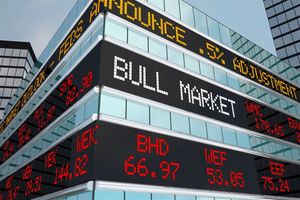
Wall Street is currently awash in a wave of optimism, fueled by the strong conviction that the Federal Reserve is poised to initiate interest rate cuts as early as September 2025. This bullish sentiment is further bolstered by a robust corporate earnings season, particularly within the technology sector, which has seen an impressive number of companies exceeding expectations. However, beneath this veneer of confidence, a growing chorus of analysts is sounding alarms about potential investor complacency, warning that the market may be overlooking significant underlying risks, including a cooling labor market and historically concentrated valuations.
This prevailing optimism, while driving market benchmarks to new highs, presents a complex picture. The anticipation of lower borrowing costs is a powerful stimulant for equity markets, promising to enhance corporate profitability and make stocks more attractive relative to fixed-income investments. Yet, the very strength of this rally, concentrated in a handful of mega-cap technology firms, coupled with a noticeable decline in market volatility, suggests a potentially dangerous level of comfort among investors, raising questions about the sustainability of the current upward trajectory.
The Dual Narrative: Rate Cut Hopes and Red Flags
The current market narrative is largely shaped by two dominant forces: the fervent expectation of Federal Reserve interest rate cuts and a surprisingly strong corporate earnings season. The CME FedWatch Tool now indicates a near-unanimous 99.9% probability of a 25-basis-point rate cut by the Federal Reserve in September 2025. This conviction stems from recent economic data, including a Consumer Price Index (CPI) report that aligned with expectations, easing inflation concerns, and a noticeable cooling in the labor market. Lower interest rates are widely anticipated to reduce borrowing costs for businesses and consumers, thereby stimulating economic activity and making equities a more appealing investment. Projections from institutions like Goldman Sachs (NYSE: GS) even suggest the possibility of three 25-basis-point cuts throughout 2025.
Complementing these rate cut expectations are the robust corporate earnings reports from the second quarter of 2025. Approximately two-thirds of S&P 500 (INDEXSP: .INX) companies have reported, with an impressive 82% surpassing earnings predictions and 79% exceeding revenue forecasts—the highest rates observed since Q2 2021. Overall, S&P 500 earnings are projected to achieve a substantial 15% increase in the coming year. The technology and finance sectors have demonstrated particular resilience, with significant growth driven by sustained investments in artificial intelligence (AI) and digital services. Mega-cap technology companies, often referred to as the "Magnificent 7," have been instrumental in driving this profit growth, accounting for a substantial portion of the S&P 500's gains.
However, this bullish sentiment is not without its caveats. A significant concern is the growing investor complacency, with some analysts warning that the market is overlooking several key risks. The VIX (INDEXCBOE: VIX), often dubbed Wall Street's "fear gauge," recently plunged to its lowest point in 2025, suggesting that traders are pricing in almost no volatility. This perceived lack of concern is viewed as a dangerous sign, as it can lead to a heightened appetite for risk without adequate consideration of potential downsides. Furthermore, while a cooling labor market supports the case for Fed rate cuts, it also presents a potential risk. July's job growth came in significantly below expectations, and previous months' data were revised lower, with the unemployment rate ticking up to 4.2% from 4.1%. This weakening in the labor market, if it deteriorates further, could signal broader economic pressures and potentially lead to a recession.
Another major red flag is the extreme concentration of market valuations. The top 10% of the largest U.S. stocks now control a record 76.5% of the total market, surpassing levels seen before the Great Depression in the 1930s and the Dot-Com bubble peak in 2000. Within the S&P 500, the top 10 stocks account for a record 40% of the index's total market capitalization, with Nvidia (NASDAQ: NVDA) alone representing roughly 8%. This high concentration means that the market's fate is heavily tied to a small cluster of stocks, primarily mega-cap technology companies. Such concentrated leadership, while driving current gains, creates systemic risk, as any significant weakness in these few names could disproportionately impact broader market performance and investor confidence. The S&P 500's forward price-to-earnings (P/E) ratio is currently elevated, trading well above its long-term and 10-year averages, suggesting that a lot of good news is already priced into stocks.
The Shifting Sands: Winners and Losers in a Complacent Market
In a market characterized by high hopes for rate cuts and concentrated valuations, the landscape for winners and losers becomes sharply defined. Companies that stand to gain the most are typically those with high growth potential, often in the technology sector, and those that benefit significantly from lower borrowing costs. Conversely, businesses sensitive to economic slowdowns or those with less robust balance sheets may find themselves on the losing end.
The clear winners in this environment are the mega-cap technology companies, particularly those at the forefront of artificial intelligence and digital transformation. Companies like Nvidia (NASDAQ: NVDA), Microsoft (NASDAQ: MSFT), Apple (NASDAQ: AAPL), Alphabet (NASDAQ: GOOGL), and Amazon (NASDAQ: AMZN) have been the primary beneficiaries of strong earnings and investor enthusiasm. Their robust balance sheets, dominant market positions, and continued innovation in high-growth areas make them attractive in a low-interest-rate environment, as their future earnings are discounted at a lower rate, increasing their present value. Furthermore, their ability to generate significant free cash flow allows them to weather potential economic headwinds more effectively than smaller, less established firms.
Financial institutions, particularly those with diversified revenue streams and strong lending portfolios, could also see a boost from rate cuts, albeit with a nuanced impact. While lower rates might compress net interest margins initially, they could also stimulate loan demand and reduce the risk of defaults, ultimately benefiting banks like JPMorgan Chase (NYSE: JPM) and Bank of America (NYSE: BAC) in the long run. Additionally, sectors that are highly sensitive to consumer spending, such as retail and discretionary consumer goods, could experience a resurgence as lower interest rates potentially free up consumer capital and encourage borrowing for larger purchases.
On the other hand, companies that are highly leveraged or operate in cyclical industries heavily dependent on robust economic growth could face significant challenges. A cooling labor market, if it translates into reduced consumer spending, could negatively impact sectors like traditional manufacturing, hospitality, and certain segments of retail that cater to a broader consumer base. Furthermore, smaller companies, particularly those that rely heavily on debt financing for expansion, might struggle even with lower interest rates if overall economic demand falters or if investor sentiment shifts away from riskier assets.
The concentration of market gains in a few large-cap stocks also means that a vast majority of companies are not participating equally in the rally. This creates a scenario where many mid-cap and small-cap companies, despite potentially solid fundamentals, may be overlooked by investors chasing the momentum of the "Magnificent 7." This divergence could lead to underperformance for a significant portion of the market, even as headline indices reach new highs, creating a challenging environment for active managers seeking alpha outside of the dominant tech giants.
Broader Implications: A Fragile Foundation for Growth
The current market dynamics, characterized by optimistic rate cut expectations and concentrated gains, fit into a broader trend of increasing market bifurcation and a reliance on monetary policy to sustain growth. This event highlights a significant shift in investor behavior, where the pursuit of yield and growth has increasingly gravitated towards a select few, highly liquid, and fundamentally strong technology companies. This trend, while rewarding for those invested in these giants, raises questions about the overall health and breadth of the market.
The potential ripple effects on competitors and partners are substantial. Smaller technology firms, while benefiting from the overall AI boom, may find it increasingly difficult to compete for talent and market share against the entrenched dominance of the mega-caps. In other industries, the perceived strength of the market might mask underlying vulnerabilities. For instance, while strong corporate earnings are celebrated, the fact that much of this growth is concentrated in a few sectors means that many traditional industries might still be grappling with inflationary pressures, supply chain disruptions, and softening demand. This could lead to a widening gap between the performance of different sectors, with capital disproportionately flowing into the perceived safe havens of large tech.
From a regulatory and policy perspective, the extreme concentration of market capitalization could attract increased scrutiny. Concerns about monopolistic practices, data privacy, and the systemic risk posed by a few dominant players could lead to calls for stricter antitrust enforcement or new regulations. Historically, periods of high market concentration have often preceded significant market corrections, as seen before the Dot-Com bubble burst in 2000. The current situation, with the top 10% of U.S. stocks controlling a record 76.5% of the total market, surpasses even the levels seen before the Great Depression in the 1930s. This historical precedent serves as a stark reminder of the potential fragility of such a narrowly led market rally.
Furthermore, the perceived easing of tariff anxieties, while contributing to investor confidence, remains a volatile factor. The threat of fresh U.S. tariffs could still crimp profit margins across various economic sectors and potentially fuel inflation, undermining the very premise of future rate cuts. The resurgence of "meme stocks," driven by speculative fervor rather than fundamental performance, is another indicator of a market exhibiting signs of irrational exuberance, reminiscent of past speculative bubbles. This broader context suggests that while the market appears robust on the surface, its foundation may be more fragile than many investors currently perceive.
What Comes Next: Navigating Uncertainty and Opportunity
The immediate future for Wall Street hinges significantly on the Federal Reserve's actions and the trajectory of economic data. In the short term, if the Fed indeed initiates rate cuts in September, it could provide a further boost to equity markets, particularly for growth-oriented stocks. This could lead to continued inflows into equities, potentially drawing some of the $7 trillion currently held in money market funds into the stock market as yields on these funds decline. However, the extent of this rally will depend on whether the rate cuts are perceived as a proactive measure to stimulate growth or a reactive response to a deteriorating economy.
In the long term, the market faces several critical junctures. The sustainability of the current rally will depend on whether corporate earnings growth can broaden beyond the mega-cap technology companies. If the cooling labor market translates into a more significant economic slowdown or even a recession, the optimistic outlook for corporate profits could quickly dissipate, leading to a market correction. Investors will need to closely monitor key economic indicators, including inflation data, employment reports, and consumer spending trends, for signs of either continued resilience or impending weakness.
Potential strategic pivots or adaptations will be required from both companies and investors. Businesses, particularly those outside the dominant tech sector, may need to focus on cost efficiencies, innovation, and niche market opportunities to thrive in a potentially more challenging economic environment. Investors, on the other hand, might need to re-evaluate their portfolio diversification strategies, considering whether their current allocations adequately account for the risks associated with concentrated market valuations and potential shifts in market leadership.
Market opportunities may emerge in sectors that have been overlooked during the tech-led rally, particularly if a broader economic recovery takes hold. Value stocks, small-cap companies, and international markets could present compelling opportunities if the market rotation broadens. Conversely, challenges include the risk of stagflation, where economic growth slows while inflation remains elevated, and the potential for increased volatility if geopolitical tensions or domestic policy shifts introduce unexpected disruptions. The ongoing rise in corporate bankruptcies, which have surged to 15-year highs in the first seven months of 2025, also signals underlying financial pressure that could intensify if economic conditions worsen.
Conclusion: A Delicate Balance of Hope and Caution
Wall Street's current optimism, largely predicated on anticipated Federal Reserve interest rate cuts and robust corporate earnings, presents a compelling yet complex picture. The market's ascent, driven primarily by a handful of mega-cap technology companies, reflects a strong belief in continued growth and a favorable monetary policy environment. The impressive earnings reports from the second quarter of 2025, particularly from the tech sector, have undoubtedly fueled this bullish sentiment, suggesting that corporate America remains resilient.
However, beneath this veneer of confidence lies a delicate balance. The pervasive investor complacency, evidenced by the plunging VIX and the market's seemingly unshakeable belief in a soft landing, raises significant concerns. The cooling labor market, while providing justification for rate cuts, also signals potential economic headwinds that could dampen consumer spending and corporate profitability. More critically, the historically concentrated market valuations, with a disproportionate share of the S&P 500's gains tied to a few dominant players, introduce systemic risk. Any significant weakness in these bellwether stocks could have a cascading effect across the broader market, challenging the sustainability of the current rally.
Moving forward, investors should exercise a blend of hope and caution. While the prospect of lower interest rates and continued technological innovation offers genuine opportunities, it is crucial to remain vigilant about the underlying risks. Key takeaways include the importance of diversified portfolios, a critical assessment of individual company fundamentals beyond headline earnings, and a keen eye on macroeconomic indicators. What investors should watch for in the coming months includes the Federal Reserve's actual rate decisions, the evolution of the labor market, and any signs of broadening or further concentration in market leadership. The lasting impact of this period will depend on whether the market can transition from a narrowly led rally to a more fundamentally driven and broadly participated expansion, or if the current complacency ultimately leads to a more significant re-evaluation of risk.


















